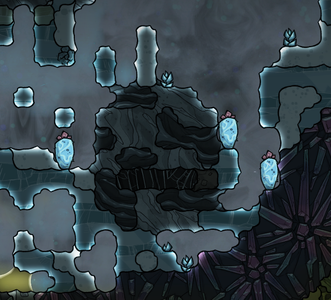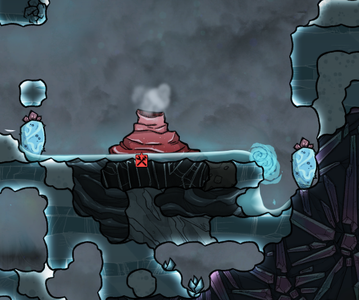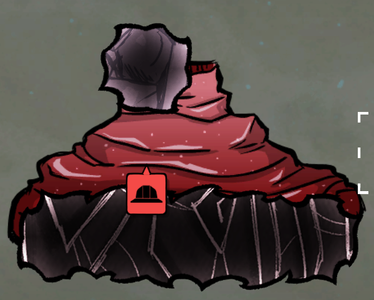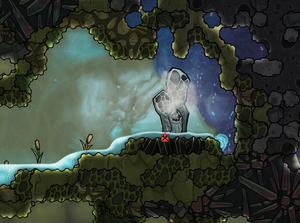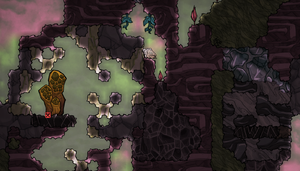Geyser
Geysers are renewable sources of various materials. When active, they alternate between erupting and Idle. The types of geysers, spawned on the map, ultimately decide the economy of the colony.
A Duplicant with the Field Research skill can analyze a geyser in order to figure out its activity duration and dormancy duration.
Dealing with Geysers
Many geysers periodically output a large volume of either heat or troublesome elements when uncovered.
A geyser is considered covered if the tile two tiles above the middle left Neutronium tile of the geyser's base is covered. In this state it does not emit anything and cannot be analyzed. Digging out other geyser tiles is safe and can be used to determine the type of the geyser.
A Geyser's type can also be checked by setting their priority to yellow alert with the Priority Tool, then hovering over the yellow alert.
Low temperature geysers can be contained with a simple Insulated Tile box. Volcanoes require at least inner obsidian box (most other materials will eventually melt) and some form of vacuum heat isolation in the long-term.
All geysers' eruptions can be halted by submerging their second bottom row in liquid. Low pressure geysers can be drowned even by gases, usually they do it to themselves. Partial drowning can also help cool down and recover metals.
Output Distribution
All geyser types randomly select an average active yield, eruption periods and percentages, and active periods and percentages; these values are picked independently.
These values are then remapped based on this formula (graph by Google): where x is a random value from 0 to 1. This leads to a probability density distribution of on this formula: A randomly generated value has an 50% chance of being in the middle 20% (exactly between 0.409 and 0.591), and a 90% chance of falling in the middle 50% (exactly between 0.258 and 0.742).
The remapped random value is then applied to the range of a geyser. For example: the Cool Slush Geyser has a range between 1000 and 2000 kg/cycle while active, but half of all cool slush geysers will fall between 1409 and 1591 kg/cycle while active.
Geyser variants
Possible geyser variants and their parameters are listed in the table below, along with the element they produce at which temperature, at which atmospheric or liquid pressure they clog. As well as expected average yield and their activity cycle. From these values the emission rate can be calculated as multiplying by the ratio of activity cycle over activity percentage (and dividing by 600 ).
- For example: a Gold Volcano with
- an activity cycle lasting 800 s,
- a 5 % activity percentage, and
- an average active yield of 1000
- Its emission rate will come to 26.667 for 40 s every 800 s.
Meanwhile all geysers (with the exception of the leaky oil fissure) will have a dormancy cycle between 15000 s and 135000 s, or 25 cycles and 225 cycles in which they are active between 40 % and 80 % of the time and dormant for the remainder. Therefore, to calculate a geyser's lifetime average output one can simply multiply the average active yield by the active percentage of the dormancy cycle. The calculation of derived values is further discussed below.
| Name | Produced Element | Temp | PMAX | Average Active Yield kg/cycle | Activity Cycle (sec) | Active Percentage |
|---|---|---|---|---|---|---|
| | 95.00 °C203 °F | 500 | 3000 (±1000) | 600 (±540) | 50% (±40%) | |
| | -10.00 °C14 °F | 500 | 1500 (±500) | 600 (±540) | 50% (±40%) | |
| | 110.00 °C230 °F | 5 | 1500 (±500) | 600 (±540) | 50% (±40%) | |
| | 95.00 °C203 °F | 500 | 3000 (±1000) | 600 (±540) | 50% (±40%) | |
| | 500.00 °C932 °F | 5 | 750 (±250) | 600 (±540) | 50% (±40%) | |
| with Food Poisoning | 30.00 °C86 °F | 500 | 3000 (±1000) | 600 (±540) | 50% (±40%) | |
| | -10.00 °C14 °F | 500 | 1500 (±500) | 600 (±540) | 50% (±40%) | |
| | 2226.85 °C4040.33 °F | 150 | 300 (±100) | 780 (±300) | 5.83% (±4.17%) | |
| | 2526.85 °C4580.33 °F | 150 | 300 (±100) | 780 (±300) | 5.83% (±4.17%) | |
| | 2626.85 °C4760.33 °F | 150 | 300 (±100) | 780 (±300) | 5.83% (±4.17%) | |
| | 1726.85 °C3140.33 °F | 150 | 300 (±100) | 780 (±300) | 5.83% (±4.17%) | |
| | 3726.85 °C6740.33 °F | 150 | 300 (±100) | 780 (±300) | 5.83% (±4.17%) | |
| | 2226.85 °C4040.33 °F | 150 | 300 (±100) | 780 (±300) | 5.83% (±4.17%) | |
| | 3226.85 °C5840.33 °F | 150 | 1200 (±400) | 9000 (±3000) | 0.75% (±0.25%) | |
| | 1726.85 °C3140.33 °F | 150 | 1200 (±400) | 9000 (±3000) | 0.75% (±0.25%) | |
| | 1726.85 °C3140.33 °F | 150 | 600 (±200) | 9000 (±3000) | 0.75% (±0.25%) | |
| | 500.00 °C932 °F | 5 | 105 (±35) | 600 (±540) | 50% (±40%) | |
| | 500.00 °C932 °F | 5 | 105 (±35) | 600 (±540) | 50% (±40%) | |
| | 150.00 °C302 °F | 5 | 105 (±35) | 600 (±540) | 50% (±40%) | |
| | 165.20 °C329.36 °F | 500 | 1500 (±500) | 600 (±540) | 50% (±40%) | |
| | 326.85 °C620.33 °F | 50 | 126 (±124) | 300 (±200) | 60% (±20%) | |
| with Slimelung | 60.00 °C140 °F | 5 | 105 (±35) | 600 (±540) | 50% (±40%) | |
| | 60.00 °C140 °F | 5 | 105 (±35) | 600 (±540) | 50% (±40%) | |
| | 500.00 °C932 °F | 5 | 105 (±35) | 600 (±540) | 50% (±40%) | |
| | -55.15 °C-67.27 °F | 50 | 150 (±50) | 600 (±540) | 50% (±40%) |
Derived Calculations
A geyser's average active yield (one of their main randomized parameters) is not shown directly to players; nonetheless, it can be derived quite easily using only the geyser's average overall yield (shown in a fully-analyzed geyser's information window under "average output") and its active amount percentage (which is shown under "active period" - e.g. a geyser active for 48.9 cycles every 76.8 cycles has an active amount percentage of roughly 63.7%):
For example: a Copper Volcano which is active for 48.9 cycles every 76.8 cycles and emits 311.8 g/s on average will have an active yield of 311.8 / 0.637 ≈ 490 g/s; multiplying by 600 gives about 293.7 kg/cycle.
Similarly, it is equally easy to go in reverse: if you have a geyser's average active yield and its active amount percentage, its average overall yield is:
Using the same example as above, a Copper Volcano which is active for 48.9 cycles every 76.8 cycles and emits 490 g/s while active on average will have an average overall yield of 490 * 0.637 ≈ 312 g/s; multiplying by 600 gives about 187.2 kg/cycle.
Calculating the eruption rate of a geyser, which is the rate at which the geyser actually emits its contents, is done similarly using the average active yield (see above) and the eruption amount (which is shown under "eruption period" - e.g. a geyser which erupts for 349 seconds every 719 seconds has an active amount percentage of roughly 48.5%):
For example, a Steam Vent which emits 3070.9 g/s of Steam for 349s every 719s will have an active yield of 3070.9 * 0.485 ≈ 1489 g/s (893 kg/cycle) - notably higher than the middle 20% for that parameter. If that same geyser is active for 77.5 cycles every 117.6 cycles (≈ 66%), then we can calculate its average overall yield to be 1489 * 0.66 ≈ 982 g/s. (The real geyser these values were taken from had an in-game average overall yield of 982.3 g/s.)
Geyser Spawning Rules - Basic Asteroids
All geysers are spawned as part of biomes, with a specified amount for each biome.
Open Geysers
- Swamp Biome:
- One open cool steam vent
- One open natural gas vent
- Caustic Biome:
- One open cool steam vent
- One open natural gas OR chlorine vent
- Tide Pool Biome:
- One open saltwater geyser
- Volcanic Biome on Rime Asteroid:
- 5 open volcanoes
- Volcanoes World Trait
- 8 open volcanoes
Buried Geysers
There are 12 randomly spawned buried geysers in each game. The Geoactive World Trait increases the number to 16, and the Geodormant World Trait decreases the number to 9.
These buried geysers are randomly spawned all over the map, except in the start Biome, Volcanic Biome, and Space Biome. These geysers start covered with granite and obsidian. In some cases, maps will contain less than what is listed due to points of interest overwriting each-other due to close proximity, especially in the Oil Biome.
As a convenient rule of thumb, each biome type will only have at most two buried geysers.
Geyser Spawning Rules - Asteroid Clusters (Spaced Out DLC)
Each asteroid within a cluster has a specific list of open geysers, which can be seen by selecting the asteroid in the starmap.
The list of geysers for each asteroid type is as follows:
- Swampy Asteroid
- 1 Cool Salt Slush Geyser (exposed)
- 1 Cool Slush Geyser (exposed)
- 1 Cool Steam Vent (exposed)
- 1 Hydrogen or Chlorine Gas Vent (exposed)
- 0-3 Minor Volcano
- Forest Asteroid
- 1 Cool Salt Slush Geyser (exposed)
- 1 Cool Slush Geyser (exposed)
- 1 Cool Steam Vent (exposed)
- 1 Hydrogen or Chlorine Gas Vent (exposed)
- 0-3 unique of:
- Chlorine Gas Vent
- Hydrogen Vent
- Minor Volcano
- Liquid Sulfur Geyser
- 0-3 Minor Volcano
- Oily Swamp Asteroid
- 0-5 unique of:
- Chlorine Gas Vent
- Natural Gas Geyser
- Carbon Dioxide Vent
- Hydrogen Vent
- Minor Volcano
- Carbon Dioxide Geyser
- Liquid Sulfur Geyser
- 1 Liquid Sulfur Geyser
- 2-5 Oil Reservoir
- 0-5 unique of:
- Rusty Oil Asteroid
- 0-4 unique of:
- Chlorine Gas Vent
- Natural Gas Geyser
- Carbon Dioxide Vent
- Minor Volcano
- Carbon Dioxide Geyser
- Liquid Sulfur Geyser
- 1 Liquid Sulfur Geyser
- 2-5 Oil Reservoir
- 0-4 unique of:
- Irradiated Asteroids
- 1-2 Gold Volcano
- Irradiated Forest and Irradiated Marsh Asteroids
- 1-2 Aluminum Volcano
- Irradiated Swampy Asteroid
- 1-2 Cobalt Volcano
- 0-4 unique of (0-5 on Irradiated Forest Asteroid):
- Chlorine Gas Vent
- Natural Gas Geyser
- Hot Polluted Oxygen Vent
- Minor Volcano
- Hydrogen Vent
- Polluted Water Vent
- Salt Water Geyser (only on Irradiated Forest Asteroid)
- Tundra Asteroid
- 2-5 Iron Volcano
- Marshy Asteroid
- 1 Tungsten Volcano
- 0-2 Tungsten Volcano (Magma)
- 0-5 unique of:
- Infectious Polluted Oxygen Vent
- Natural Gas Geyser
- Chlorine Gas Vent
- Carbon Dioxide Vent
- Hydrogen Vent
- Hot Polluted Oxygen Vent
- Superconductive Asteroid
- 1 Niobium Volcano
- Moo Asteroid
- 1 Chlorine Gas Vent
- Water Asteroid
- 0-2 unique of:
- Polluted Water Geyser
- Cool Slush Geyser
- Salt Water Geyser
- Water Geyser
- 0-2 unique of:
Geyser Probabilities
There are 25 unique geysers to pick from for each of the 12 randomly chosen geysers, each having the same chance of selection. This can be broken down into groups:
- Water-producing: 7 (polluted water can be sieved, steam can be cooled, salt water and brine can be desalinated)
- Oxygen-producing: 2 (polluted O2 can be deorderized)
- Volcanic: 2
- Metal-producing: 7
- Combustion Power: 3 (natural gas, leaky oil, hydrogen)
- Other: 4 (sulfur, chlorine, CO2)
Ignoring geysers forced by the biome type or planetoid type (i.e. cool steam vent in swamp), and assuming 9 of the 12 randomly chosen geysers exist on a given world (oil biome geysers often get overwritten by other POIs), the odds for getting at least a certain number of a preferred geyser or group of geysers are as follows:
| Number of types preferred | ||||||||
|---|---|---|---|---|---|---|---|---|
| 1 | 2 | 3 | 4 | 5 | 6 | 7 | ||
| Min amount wanted |
1 | 30.75% | 52.78% | 68.35% | 79.18% | 86.58% | 91.54% | 94.8% |
| 2 | 4.78% | 15.83% | 29.51% | 43.48% | 56.38% | 67.5% | 76.6% | |
| 3 | 0.45% | 2.98% | 8.33% | 16.29% | 26.18% | 37.13% | 45.03% | |
| 4 | 0.03% | 0.37% | 1.58% | 4.2% | 8.56% | 14.75% | 22.6% | |
| 5 | 0.001% | 0.03% | 0.21% | 0.75% | 1.96% | 4.16% | 7.62% | |
| 6 | 0% | 0.002% | 0.02% | 0.09% | 0.31% | 0.81% | 1.79% | |
All listed values assume repetition within the set of preferred geysers doesn't matter (ex. getting two Gold volcanoes, rather than a Gold and Tungsten). The odds of getting multiple distinct geysers will be worse. Note that on world with the Geoactive trait, or where fewer geysers are overwritten by other POIs, the resulting odds may be greater than listed.
As an example, if a world with at least two volcanoes is desired, it should have a 15.83% chance per world (2 preferred, 2 wanted). If at least one metal volcano is desired, it should have a 94.8% chance per world (7 preferred, 1 wanted).
As a corollary, ignoring forced-spawn geysers, any given world has at least a 94.8% chance of having at least one water geyser source, a 94.8% chance of having at least one metal geyser, a 68.35% chance of having a geyser producing a combustion power resource, a 52.78% chance of having at least one volcano, and a 52.78% chance of having a geyser directly producing oxygen.


